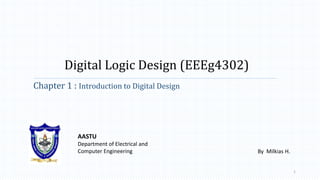
Chapter 1_Introduction to digital design (EEEg4302).pdf
- 1. Digital Logic Design (EEEg4302) Chapter 1 : Introduction to Digital Design AASTU Department of Electrical and Computer Engineering 1 By Milkias H.
- 2. Outline • Chapter 1 : Introduction to Digital Design • Digital and Analogue Quantities • Binary digits, Logical levels and Digital wave form. 2
- 3. Digital and Analogue Quantities • What is signal ? o In electronics, a signal is an electric current or electromagnetic field used to convey data (encode message) from one point to another. • How electric current can be used to encode a messages ? o By varying the voltage of an electric current. o A message can be encoded by changing the voltage of an electric current is called electronic signal. o The use of electric current for this purpose is called electronics. • Electronic signals can be analog or digital signals. o Analog signals : consists of continuously changing voltage in an electric current. It is a set of continuous values with infinitely small variations. The quantity that has continuous values is called as the analog quantity. o Digital signals : consists of rapid pulses of voltage that repeatedly switches the current off and on. It is a set of discrete values with in instantaneous change sampled at moments in time and quantized. The quantity that has a discrete set of values is called as the digital quantity. 3
- 4. Digital and Analogue Quantities • Why are we changing analog to digital? The four main advantages of digital. o Digital data can be processed more efficiently. o It can be transmitted more efficiently and reliably. o It can be stored more compactly. o It can be reproduce with greater accuracy and clarity o Security o Cost and so on. 4 } Noise (unwanted fluctuation) affects analog signal more than the Digital one.
- 5. Outline • Chapter 1 : Introduction to Digital Design • Digital and Analogue Quantities • Binary digits, Logical levels and Digital wave form 5
- 6. Binary Digits • Digital electronics involves circuits and systems in which there are two types of possible states. • These states are represented by two different voltage levels: HIGH and LOW. • In digital systems such as computers; combinations of two states, called codes, are used to represent numbers, symbols, alphabetic characters and other types of information. • The two-state number system is called binary and its two digit are called Binary Digit: 0 and 1. 6
- 7. Binary Digits Each of the Binary digit '0’ and ‘1’ is called bit (A unit of measurement of information). • In digital circuits, two different voltage levels are used to represent the two bits. Generally; o 1 is represented by the higher voltage (HIGH) and o 0 is represented by the lower voltage (LOW). 7
- 8. Logic Levels A logic level is a specific voltage or a state in which a signal can exist. Usually, the term refers to binary logic in which two levels or states can exist: logic 1 (also called the high state) and logic 0 (also called the low state). The voltage used to represent a ‘1’ and ‘0’ are logic levels. • Ideally, one voltage level represents a HIGH and another voltage level represents a LOW. • In a practical digital circuit, however, a HIGH can be any voltage between a specified minimum value and specified maximum value. Likewise for a LOW voltage levels. • There can be no overlap between the accepted range of HIGH levels and the accepted range of LOW levels. 8
- 9. Logic Levels The voltage values between VH(min) and VL(max) are unacceptable for proper operation (invalid or uncertain region). ● The voltage values between VH(max) and VH(min) are HIGH. ● The voltage values between VL(max) and VL(min) are LOW. 9
- 10. Digital Waveforms • Digital waveforms consists of voltage levels that are changing back and forth between the HIGH and LOW levels or states. • Usually these waveforms are represented as timing diagrams used to represent wave behavior relative to time. • Pulse have two edge • A leading edge where pulse goes to HIGH from LOW state and falling edge where pulse revert. 10
- 11. Digital Waveforms • Sudden transition from one state to other is impractical (ideal). Depending on practical consideration it will take small amount of time to get from one state to another. 11 Rise Time → time required for pulse to go from LOW level to HIGH. Fall Time → time required for pulse to go from HIGH level to LOW. Amplitude → the maximum value of a digital waveform. Pulse Width → the time gap between the raising edge and falling edge.
- 12. Digital Logic Design • Digital logic design is a system in electrical and computer engineering that uses simple number value to produce input and output operations. • Digital logics are rooted in binary code. • This system facilitates the design of electronics circuits that convey information, including logic gates with functions that include AND, OR and NOT commands. • The value system translates input signals into specific output. These functions facilitate computing, robotics and other electronics applications. 12
- 13. Last slide 13